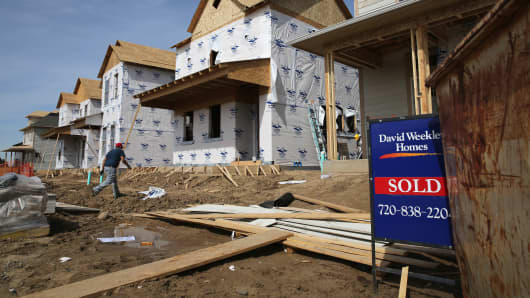(Read More: Rising Rates Rattle Mortgage Market)
Builders appear to be ramping up for more construction projects. Newly issued building permits, a gauge of future construction, rose 14.3 percent from a month earlier to an annual rate of 1.017 million, the highest level since June 2008.
Permits for single-family homes, which compromise about two thirds of the total, rose 3 percent to a 617,000-unit rate, the highest since May 2008.
Claims Turn Higher
The number of Americans filing new claims for unemployment benefits climbed last week at the fastest pace in six months, a worrisome sign for the economy which has been hit by government austerity.
Initial claims for state unemployment benefits jumped by 32,000 to a seasonally adjusted 360,000, the Labor Department said on Thursday. That was the biggest jump since November and confounded analysts' expectations for a more modest increase.
Claims for the prior week were revised to show 5,000 more applications received than previously reported.
A Labor Department analyst said no states had estimated their data, and that there were no signs furloughs for government employees played a significant role in last week's increase in claims.
The U.S. economy has shown signs that growth slowed late in the first quarter and in April as an austerity drive by the federal government weighed on consumers and businesses. Washington hiked taxes in January and initiated sweeping budget cuts in March.
(Read More: Strange Days: Roaring Markets but Sketchy Data)
Data on jobless claims has been a relative bright spot in the U.S. labor market, and analysts will be cautious over reading too deeply into one week of dour data, which showed claims at their highest since late March.
The four-week moving average for new claims, a better gauge of job market trends, remains near its lowest levels since the start of the 2007-09 recession. Last week, the moving average rose 1,250 to 339,250.
Many analysts have noted that a reticence by employers to lay off workers has made an outsized contribution to recent improvements in employment levels.
Last month, employers on net added 165,000 new jobs to their payrolls while the unemployment rate dropped to a four-year low at 7.5 percent.
The improvement in employment has contrasted sharply with other data, including retail sales and manufacturing, that have suggested a modest cooling in the economy at the end of the first quarter that persisted early in the April-June period.
The claims report showed the number of people still receiving benefits under regular state programs after an initial week of aid dropped 4,000 to about 3 million in the week ended May 4.
Prices Fall
A sharp drop in gasoline costs led U.S. consumer prices to tumble in April by the most in over four years, while a gauge of underlying inflation was so weak it could worry the U.S. Federal Reserve.
The Labor Department said on Thursday its Consumer Price Index slipped 0.4 percent, the biggest decline since December 2008 when America was suffering some of the darkest days of its financial crisis. Analysts had expected a more modest 0.2 percent decline in last month's prices.
The signs of muted inflation pressures could bolster the case for the Fed to remain on its very easy monetary policy path, despite divisions among policymakers over money printing to buy bonds.
In the 12 months through April, consumer prices rose 1.1 percent. That is well below the Fed's 2 percent inflation goal. The U.S. central bank targets a different gauge of prices that tends to run cooler than the Labor Department's index.
(Read More: Commodity Fears and China Trouble Fund Managers)
Much of April's decline in prices was fueled by an 8.1 percent dive in gasoline costs, the biggest decline since December 2008.
However, the weakness in the index also extended to a measure of underlying inflation that strips out volatile energy and food prices.
That gauge rose just 0.1 percent, and was up only 1.7 percent from a year earlier. Apparel prices dropped 0.3 percent.
The annual reading for core inflation was at its lowest since June 2011 and could stoke concerns over cooling demand in the U.S. economy, or perhaps even the risk of outright deflation.
Most economists and investors don't think deflation is very likely for America in the coming years, but it would be a central banker's nightmare. Deflation involves spiraling declines in prices and wages and is difficult for policymakers to combat.




